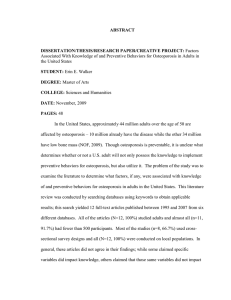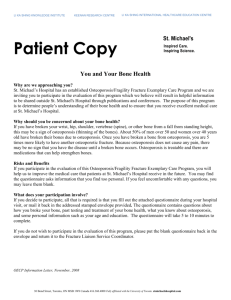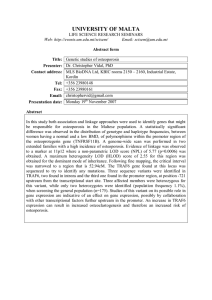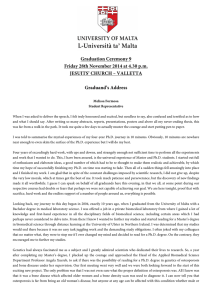Document 14233342
advertisement
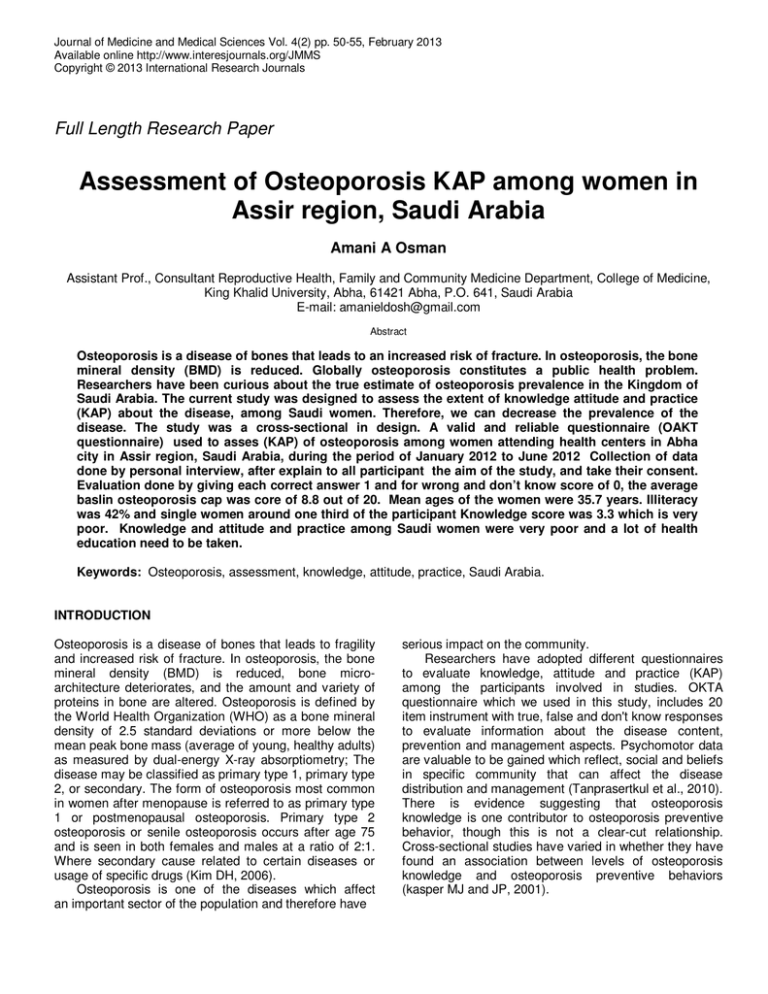
Journal of Medicine and Medical Sciences Vol. 4(2) pp. 50-55, February 2013 Available online http://www.interesjournals.org/JMMS Copyright © 2013 International Research Journals Full Length Research Paper Assessment of Osteoporosis KAP among women in Assir region, Saudi Arabia Amani A Osman Assistant Prof., Consultant Reproductive Health, Family and Community Medicine Department, College of Medicine, King Khalid University, Abha, 61421 Abha, P.O. 641, Saudi Arabia E-mail: amanieldosh@gmail.com Abstract Osteoporosis is a disease of bones that leads to an increased risk of fracture. In osteoporosis, the bone mineral density (BMD) is reduced. Globally osteoporosis constitutes a public health problem. Researchers have been curious about the true estimate of osteoporosis prevalence in the Kingdom of Saudi Arabia. The current study was designed to assess the extent of knowledge attitude and practice (KAP) about the disease, among Saudi women. Therefore, we can decrease the prevalence of the disease. The study was a cross-sectional in design. A valid and reliable questionnaire (OAKT questionnaire) used to asses (KAP) of osteoporosis among women attending health centers in Abha city in Assir region, Saudi Arabia, during the period of January 2012 to June 2012 Collection of data done by personal interview, after explain to all participant the aim of the study, and take their consent. Evaluation done by giving each correct answer 1 and for wrong and don’t know score of 0, the average baslin osteoporosis cap was core of 8.8 out of 20. Mean ages of the women were 35.7 years. Illiteracy was 42% and single women around one third of the participant Knowledge score was 3.3 which is very poor. Knowledge and attitude and practice among Saudi women were very poor and a lot of health education need to be taken. Keywords: Osteoporosis, assessment, knowledge, attitude, practice, Saudi Arabia. INTRODUCTION Osteoporosis is a disease of bones that leads to fragility and increased risk of fracture. In osteoporosis, the bone mineral density (BMD) is reduced, bone microarchitecture deteriorates, and the amount and variety of proteins in bone are altered. Osteoporosis is defined by the World Health Organization (WHO) as a bone mineral density of 2.5 standard deviations or more below the mean peak bone mass (average of young, healthy adults) as measured by dual-energy X-ray absorptiometry; The disease may be classified as primary type 1, primary type 2, or secondary. The form of osteoporosis most common in women after menopause is referred to as primary type 1 or postmenopausal osteoporosis. Primary type 2 osteoporosis or senile osteoporosis occurs after age 75 and is seen in both females and males at a ratio of 2:1. Where secondary cause related to certain diseases or usage of specific drugs (Kim DH, 2006). Osteoporosis is one of the diseases which affect an important sector of the population and therefore have serious impact on the community. Researchers have adopted different questionnaires to evaluate knowledge, attitude and practice (KAP) among the participants involved in studies. OKTA questionnaire which we used in this study, includes 20 item instrument with true, false and don't know responses to evaluate information about the disease content, prevention and management aspects. Psychomotor data are valuable to be gained which reflect, social and beliefs in specific community that can affect the disease distribution and management (Tanprasertkul et al., 2010). There is evidence suggesting that osteoporosis knowledge is one contributor to osteoporosis preventive behavior, though this is not a clear-cut relationship. Cross-sectional studies have varied in whether they have found an association between levels of osteoporosis knowledge and osteoporosis preventive behaviors (kasper MJ and JP, 2001). Osman 51 In Saudi Arabia the magnitude of osteoporosis problem is not yet clearly weighed. In previous study; osteoporosis was more common among Type 2 diabetic postmenopausal Saudi females than the non-diabetics. Since both groups were postmenopausal, having equal percentage of Vitamin D deficiency, multi-parity, non exposure to sun, lack of exercise and negligible milk intake, this concluded that the low BMD can be attributed to DM in the absence of other causes of osteoporosis (AlMaatouq MA, 2004). A study on osteoporosis in postmenopausal Saudi women using dual x-ray bone densitometry, concluded that bone densitometry should be used to assess the severity of bone loss, identify those who need therapy and for follow up and early diagnosis of those with osteopenia in order to institute proper therapy and avoid future osteoporosis (El-Desouki MI, 2003 , El-Desouki MI, 2005). Osteoporosis risks can be reduced with lifestyle changes and sometimes medication; in people with osteoporosis, treatment may involve both. Lifestyle change includes diet and exercise, and preventing falls. Medication includes calcium, vitamin D, bisphosphonates and several others. Fall-prevention advice includes exercise to tone deambulatory muscles, proprioceptionimprovement exercises; equilibrium therapies may be included. Exercise with its anabolic effect, may at the same time stop or reverse osteoporosis. Osteoporosis is a component of the frailty syndrome. This study aimed to assess the level of accuracy of the estimate of HIV prevalence with the view to knowing the direction of the estimate. It also strives to identify factors that are predictors of being infected with HIV virus in Nigeria. These objectives would provide information on how to strengthen HIV estimate and create an avenue for the implementation of various evaluations of HIV programmes in Nigeria and other countries with similar population structure. This will assist in actualization of the sub-theme of Millennium Development Goals to combat HIV/AIDS in Nigeria. MATERIAL AND METHODS The study area The study was a cross-sectional in design. It was conducted in 5 health centers in Abha city ( Almanhal, Shamsan, Alnmus, Al mansak, Al Azizia ) in Assir region, South West of Saudi Arabia, during the period of January 2012 to June 2012 . Sampling procedure and Data collection Data collected to assess Knowledge attitude and practice (KAP) about osteoporosis among Saudi women attending 5 health centers for deferent reasons. Their age were 15 years and above. The investigation procedures followed were in accordance with the ethical standards of the responsible committee on human experimentation (Research Center For Medical Colleges, King Khalid University) and with the Helsinki Declaration of 1975, as revised in 2000. Informed consent was obtained from the participants after clear explanation of this study. Primary data were collected by personal interview using wellstructured questionnaire. A valid and reliable questionnaire OAKT questionnaire used to asses (KAP) of osteoporosis among women (Tania M Winzenberg*1 and 2003). It included 20 questions which is sociodemographic characteristics, 12 questions about knowledge, question 13 to 16 about attitude towards the disease and last 4 questions about perception and practice towards prevention of osteoporosis. Evaluation done by giving each correct answer 1 and for wrong and don’t know score of 0, the average baseline osteoporosis (KAP) was score of 8.8 out of 20. Data analysis Data were analyzed using SPSS. RESULTS Socio-demographic characteristics of women Overall, a total of 119 women attending 5 health centers in Abha city ( Almanhal, Shamsan, Alnmus, Al mansak, Al Azizia ), their age above 15 years, were involved in the study . The mean ages for the participants were 35.7years. Age group was shown in table 1. There was a wide variation of educational level among participants but all those above 45 years old (42.8% ) were illiterate. Marital status: around 60% of the participants were married. The evaluation of knowledge question was 3.3 out of 12, which is very low according to the score of OKTA, and that means knowledge about the disease was very poor among study group. The lowest score was on the question about that the disease is common in men; almost 90% did not know the right answer. They agreed that this disease is a disease of men. The highest score among questions of knowledge was that question about the increase chance of fracture. Regarding attitude and practice to prevent the disease. The total score was 3.1, again it is very poor. Especially among young females (15-19yrs) which is very serious. Almost 90% of this group did not know the right answer. Figure 1 and 2 show response to food practice and individual practice. The majority of patients (57.1%) had limited activity and 71.2% had no outdoor work at all or doing exercise. 52 J. Med. Med. Sci. Table 1. AGE Distribution of the participants Age group 15-25Yrs 26-35Yrs 46-55Yrs 56Yrs and above Total Frequency 27 35 38 19 119 Percent % 22.6 29.6 31.9 15.9 100.0 Table 2. Cross tabulation between response of age towards the effect of exercise and pain Count PAIN TRUE AGE FALSE Total AGE DON'T KNOW Total AGE EXERCISE TRUE FALSE 15-25YRS 23 26-35YRS 22 26-35YRS 14 46-55YRS 22 56YRS AND ABOVE 15 36 15 46-55YRS - Total Figure 1. Provide legend Figure 2. Provide legend Total DONOT KNOW 10 18 29 17 33 18 51 14 22 15 51 17 17 17 Osman 53 None of them had a regular sport activity. Table 2 show the response of different age group towards the knowledge of effect of exercise and occurrence of pain as symptoms of osteoporosis. DISCUSSION Osteoporosis (OP) is a major, highly prevalent health problem which under estimated in many countries. The osteoporosis-related fractures account for high morbidity and mortality. Therefore, prevention and early detection of osteoporosis should strive to substantially reduce this risk of complications. Few studies have been conducted in Saudi Arabia (Addar et al., 2005). One of these studies done to correlate age at menopause and osteoporosis among Saudi women. All menopausal women share in the study had bone mineral density at King Khalid University Hospital, Riyadh, Saudi Arabia, between 1999 to 2003. Correspondence and logistic regression analysis were conducted to identify variables that were positively associated with age of menopause. It reveals that age of menopause among Saudi women is lower than in Western countries but similar to other Arabic countries. In addition to cultural differences genetics play a role in determining the age of menopause and the development of osteoporosis. The diagnosis of osteoporosis always shows a challenge but few risk factors have been detected in many studies (Geller and Derman, 2001, Gemalmaz and Oge, 2008). This study showed that the majority of patients (71.2%) had no outdoor work at all or doing exercise. None of them had a regular sport activity. This result was similar to a study done in Turkey, include total of 107 female patients (mean age 74 years; range 63 to 100 years) who experienced hip fractures after the age of 60 years were included in a previous study using a questionnaire to determine their physical and social characteristics, medical conditions , and nutritional status. In addition, the types of fractures were determined by radiographs. The outcomes enclosed; the mean body mass index was 23 kg/m2. The Forty-four patients (41.1%) were illiterate, and 31 patients (29%) were only literate or could finish primary school. A history of smoking was found in 29.9% for a mean duration of 30.7 years. The majority of patients (67.3%) had limited activity and 63.6% had no outdoor work at all. None of them had a regular sport activity. Only two patients (1.9%) received inadequate and short-term postmenopausal therapy. The mean daily milk consumption was less than a glass (125-150 ml). Calcium supplements were used in only 5.6%. A history of previous fractures (hip, vertebra, distal radius) was detected in 9.3%. The most common coexistent diseases were hypertension (50%) and diabetes (29%). None of the patients had bone mineral density measurements. The study showed that, despite the high incidence of risk factors for osteoporosis, few patients received medical care for the diagnosis and treatment of osteoporosis, and that preventive health care measures were not available for this patient group (Unay et al., 2005) . Another study conducted in Spain (Luz Rentero et al., 2008); 4,960 women, at 96 Primary Care centers. Demographic and anthropometrical data, as well as information regarding risk factors for OP were collected using a questionnaire. The prevalence rates for the major osteoporosis risk factors were: low calcium intake, 43%; benzodiazepine use, 35.1%, and height loss, 30.1%. Other relatively prevalent factors include: having suffered at least one fall during the preceding year; positive family history of falls (particularly on the mother's side), smoking, kyphosis, presence of any disease affecting bone metabolism, personal history of falls, and inability to rise from a chair without using one's arms. The least frequent factors were weight loss of greater than 10% over the preceding 10 years and problems in sensory perception that affect patient's ability to walk. The study concluded that; the main risk factors for osteoporosis in women 50-65 years of age are low calcium intake, use of benzodiazepines, and observed loss of height. These results may help physicians to identify groups at risk for OP and fractures at early stages and consequently, optimize prevention and early diagnosis of osteoporosis in postmenopausal women. Many factors such as social and demographic, have been reported to affect the disease distribution (Miura et al., 2010). The prevalence of this disease is affected by the poor level of women knowledge, attitude and practice (Terrio and Auld, 2002, Pande et al., 2005). From this study the age of participants in relation to their knowledge, of both elder women (>50 years) and younger ones (15 -19 years) were very poor in their knowledge this is similar to a study done in Pakistan; the knowledge on osteoporosis in younger women was found to be very poor compared to relatively older females. However, women belonging to higher socioeconomic status and better education had slightly more knowledge about osteoporosis compared to those with a low education level, regardless of age (Riaz et al., 2008). A sample of 217 women, 13 to 76 years of age, who were attending 1 of 2 health care facilities in Da Nang, Vietnam, between November and December 2009 were involved in a study in which a questionnaire completed assessing their awareness of osteoporosis and measuring their knowledge using a 30-item instrument reflecting 9 knowledge domains risk factors, diagnosis and prognosis. The results revealed, A majority (81.6%) of the women had heard of osteoporosis. Awareness was associated with education, working in health care, and having a family member with osteoporosis. On average, Vietnamese women answered 49% of the knowledge 54 J. Med. Med. Sci. questions correctly; scores ranged from 0 to 26 questions correct out of 30 (mean = 14.71 ± 5.2, median = 15). Mean knowledge scores were higher among those reporting a family member with osteoporosis, nurses (vs other vocations), and women with a high school education or greater (relative to those who had not completed high school). More than 90% of the women expressed interest in a prevention and treatment program. The study concluded that, Vietnamese women may have heard of osteoporosis, yet they would benefit from education targeting prevention and treatment of the disease (Nguyen et al., 2011). In order to measure the knowledge, attitude and practice, this should depend on the design of a valid and reliable questionnaire to measure osteoporosis knowledge in women such as the Osteoporosis Knowledge Assessment Tool (OKAT). In previous study; a questionnaire was used to collect data to explore the knowledge, attitude, and activity regarding osteoporosis of middle-aged and elderly women in Taipei, Taiwan, It was delivered by way of a face-to-face interview. The findings indicated that the mean score on a “knowledge” scale was 15.37 (SD = 11.37; total scores ranging from 0 to 44). Among six dimensions of knowledge, the highest score was noted for “incidence of osteoporosis "; and the lowest score was for “diagnosis and treatment ". For attitudes, the highest score was noted for “perceived efficacy of actions "; whereas the lowest score was for "perceived susceptibility ". For preventive activity, women revealed extremely low percentages in “checking bone mass density" (2.7%) and "reading materials relating to osteoporosis" (7.8%). Multiple and stepwise regression analyses on preventive activity indicated that six variables (knowledge, previous physical examination history, perceived severity of osteoporosis, perceived value of early detection and treatment, attainment of a senior high school degree or over, and health status) could be singled out as significant factors and accounted for 36.1% of the variance. These findings reveal that broader health educational programs and health services regarding osteoporosis are necessary for Taiwanese women (Yu and Huang, 2003). Overall the management strategies of osteoporosis has to be planned depending on community beliefs and psychometric aspects (Cadarette et al., 2007). In previous study comprised 132 patients women aged more than 50 years old whose diagnosed with osteoporosis; the management profile involved (140 fractures) included in the study had a mean age of 73.8 years. Fracture sites in decreasing order of frequency were the wrist (29%), the hip (28%), the ankle (19%), the pelvis, the humerus, and the leg. In other study, data on management by the primarycare physician were available for 106 patients. Fifty patients (50/106, 47%) were given a diagnosis of osteoporosis by their primary-care physician and 38 (38/106, 35%) received medications for osteoporosis (Briancon et al., 2004). Almost all osteoporosis studies conducted were measuring the knowledge, attitude and practice of participants. The final usage of these knowledge and practice should affect the individual attitude towards any health problem (Unson et al., 2001, von Hurst and Wham, 2007). CONCLUSION In conclusion, Osteoporosis knowledge was low among Saudi ladies, thus attitude and practices also low towards this disease. This finding is similar to other studies done in the kingdom in different cities, but there was no response. So this will enhance health authorities to create program to upraise the awareness of the community for this important disease, especially at primary health care levels and at school. ACKNOWLEDGMENTS Great thanks to the staff of Family and Community Medicine department, King Khalid University, Abha and staff of all five primary health care centers in Abha, Assir region Kingdom of Saudi Arabia. REFERENCES ADDAR M, EL DESOUKI M, BABAY Z (2005). Correlates of age at menopause and osteoporosis in Saudi women. Clin Exp Obstet Gynecol, 32:135-7. AL-MAATOUQ MA EDM, OTHMAN SA, MATTAR EH, BABAY ZA, ADDAR M (2004). Prevalence of osteoporosis among postmenopausal females with diabetes mellitus.. Saudi Med J., 25:1423-7. BRIANCON D, DE GAUDEMAR JB, FORESTIER R (2004). Management of osteoporosis in women with peripheral osteoporotic fractures after 50 years of age: a study of practices. Joint Bone Spine, 71, 128-30. CADARETTE, S. M., GIGNAC, M. A., BEATON, D. E., JAGLAL, S. B. and HAWKER, G. A. 2007. Psychometric properties of the "Osteoporosis and You" questionnaire: osteoporosis knowledge deficits among older community-dwelling women. Osteoporos Int, 18, 981-9. EL-DESOUKI MI (2003) Osteoporosis in postmenopausal Saudi women using dual x-ray bone densitometry. Saudi Med J. , 24:953-6. EL-DESOUKI MI SM, OTHMAN SA (2005). Comparison of bone mineral density with dual energy x-ray absorptiometry, quantitative ultrasound and single energy x-ray absorptiometry.. Saudi Med J., 26:1346-50. GELLER SE, DERMAN R (2001). Knowledge, beliefs, and risk factors for osteoporosis among African-American and Hispanic women. J Natl Med Assoc, 93:13-21. GEMALMAZ A, OGE A (2008). Knowledge and awareness about osteoporosis and its related factors among rural Turkish women. Clin Rheumatol, 27:723-8. KASPER MJPM, ALLEGRANTE JP (2001). The need for comprehensive educational osteoporosis prevention programs for Osman 55 young women: results from a second osteoporosis prevention survey. Arthritis Rheum, 45:28-34. KIM DH VA (2006). "Osteoporotic compression fractures of the spine; current options and considerations for treatment". The spine journal : official J. North Am Spine Soc., 6:479–87. LUZ RENTERO M, CARBONELL C, CASILLAS M, GONZALEZ BEJAR M, BERENGUER R (2008). Risk factors for osteoporosis and fractures in postmenopausal women between 50 and 65 years of age in a primary care setting in Spain: a questionnaire. Open Rheumatol J, 2:58-63. MIURA S, YAGI M, SAAVEDRA OL, YAMAMOTO S (2010). Sociodemographic variation in knowledge of osteoporosis and locally available calcium-rich foods among urban women living on low incomes in Davao, Philippines. Health Care Women Int., 31:387-401. NGUYEN NV, DINH TA, NGO QV, TRAN VD, BREITKOPF CR (2011). Awareness and Knowledge of Osteoporosis in Vietnamese Women. Asia Pac J Public Health. PANDE K, PANDE S, TRIPATHI S, KANOI R, THAKUR A, PATLE S (2005). Poor knowledge about osteoporosis in learned Indian women. J Assoc Physicians India, 53:433-6. RIAZ M, ABID N, PATEL J, TARIQ M, KHAN MS, ZUBERI L (2008). Knowledge about osteoporosis among healthy women attending a tertiary care hospital. J Pak Med Assoc, 58:190-4. TANIA M, WINZENBERG 1BO, SUE F, GRAEME J (2003). The design of a valid and reliable questionnaire to measure osteoporosis knowledge in women: the Osteoporosis Knowledge Assessment Tool (OKAT)BMC Musculoskeletal Disorders 4:, 1-7. TANPRASERTKUL C, WATTANARUANGKOWIT P, PANYAKHAMLERD K (2010). The combination of body mass index and age as a new index for identifying osteoporosis in Thai postmenopausal women. J Med Assoc Thai, 93 Suppl 7:S76-82. TERRIO K, AULD GW (2002). Osteoporosis knowledge, calcium intake, and weight-bearing physical activity in three age groups of women. J Community Health, 27, 307-20. UNAY K, DEMIRCAY E, AKAN K, SENER N (2005). Risk factors for osteoporosis in women having hip fractures after 60 years of age]. Acta Orthop Traumatol Turc, 39:295-9. UNSON CG, DUNBAR N, CURRY L, KENYON L, PRESTWOOD K (2001). The effects of knowledge, attitudes, and significant others on decisions to enroll in a clinical trial on osteoporosis: implications for recruitment of older African-American women. J Natl Med Assoc, 93, 392-401; discussion 402-4. VON HURST PR, WHAM CA (2007). Attitudes and knowledge about osteoporosis risk prevention: a survey of New Zealand women. Public Health Nutr, 10, 747-53. YU S, HUANG Y C (2003). Knowledge of, attitudes toward, and activity to prevent osteoporosis among middle-aged and elderly women. J Nurs Res, 11:65-72.
